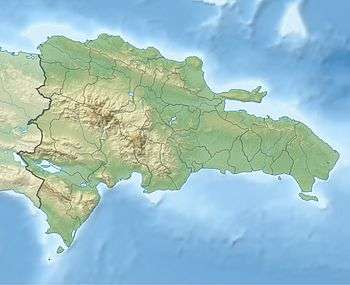Bajos de Haina
| Bajos de Haina | |
|---|---|
 Bajos de Haina Bajos de Haina in the Dominican Republic | |
| Coordinates: 18°25′12″N 70°01′48″W / 18.42000°N 70.03000°W | |
| Country |
|
| Province | San Cristóbal |
| Area[1] | |
| • Total | 38.49 km2 (14.86 sq mi) |
| Population (2012)[2] | |
| • Total | 158,985 |
| • Density | 4,100/km2 (11,000/sq mi) |
| • Urban | 79,856 |
| Municipal Districts |
1 |
Bajos de Haina (Standard Spanish pronunciation: ['ba.xos de 'ai.na]; locally: ['ba.ho de 'hai.na]), mostly known simply as Haina (Standard Spanish pronunciation: ['ai.na]; locally: ['hai.ŋa]), is a town and municipality in the San Cristóbal Province, of the Dominican Republic.
History
According to some versions, Miguel Díaz, who had migrated from La Isabela, arrived in Haina after having injured a man who was intimately related to the Spanish authorities. Once he settled there, he married a native woman named Catalina who told him of a gold deposit in the western bank of the Haina River. After confirming the existence of the precious metal, he returned to La Isabela where he told Christopher Columbus and his brother Bartholomew of his discovery. The Admiral sent his brother to confirm the existence of the deposit, since he had to leave for Europe.
Bartholomew realized that there indeed was gold and decided to build a fort that he named San Cristóbal, which served as lodging for the soldiers that participated in this activity.
A very large gold nugget was found in 1502, at the western bank of the Haina River, eight kilometers from Villa Altagracia, in a place known as Madrigal. The nugget was sent to Spain, but the ship that carried it sank along with Governor Francisco de Bobadilla, cacique Guarionex and dozens of Spaniards.[3]
Most recently the municipality of Haina is known for many years to be one the fastest growing economies within the Dominican Republic. The refinery and the zona franca or duty free zone are among the most important sources for employment in the whole province of San Cristobal.
Pollution
Bajos de Haina has been referred to as the 'Dominican Chernobyl'.[4] According to the United Nations, the population of Haina has been considered to have the highest level of lead contamination in the world, and its entire population carries indications of lead poisoning. The contamination is believed to have been caused by the past industrial operations of the nearby Baterías Meteoro, an automobile battery recycling smelter. Although the company has moved to a new site, the contamination still remains.
Bajos de Haina was named as one of the ten most polluted places on earth by the US based environmental group the Blacksmith Institute in 2006.[5]
Between December 2008 and March 2009, Blacksmith conducted cleanup, coordinating the removal of over 6,000 cubic meters of contaminated soil from the site, which has been turned into a local park. Following the remediation and a number of community education campaigns, blood lead levels have significantly dropped and are now at acceptable levels.[6] Haina is no longer on Blacksmith's list of world's worst polluted places.[7]
References
- ↑ Superficies a nivel de municipios, Oficina Nacional de Estadistica Archived April 17, 2009, at the Wayback Machine.
- ↑ Censo 2012 de Población y Vivienda, Oficina Nacional de Estadistica
- ↑ Síntesis de Ciudades, Pueblos es Islas del País M. M. Pouerié Cordero, Impresora Mary. Sto. Dgo., 1997
- ↑ New York councilman to visit "Dominican Chernobyl". Dominican Today. 21 July 2007.
- ↑ World's Worst Polluted Places — by the Blacksmith Institute (accessed 2007-12-3)
- ↑ "Lead Contamination, Haina (Success Story)".
- ↑ "Blacksmith Institute certifica HAINA ya no es de las más contaminadas". Acento.com. Dec 17, 2013. Archived from the original on 2014-02-19.
Coordinates: 18°25′N 70°02′W / 18.417°N 70.033°W